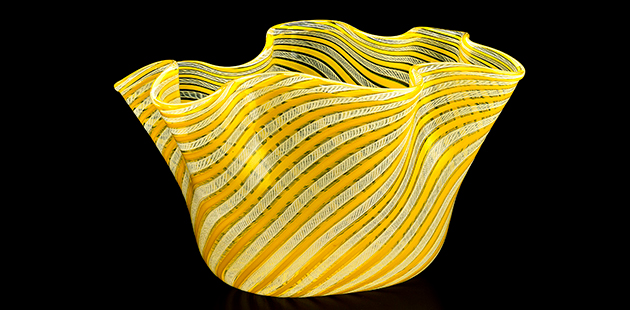 Drawing upon the National Gallery of Victoria’s extensive holdings of Venetian glass, ranging in date from the sixteenth to the twentieth century, including the NGV’s especially rich material from the nineteenth-century revival period, Liquid Light: 500 Years of Venetian Glass is now on display until April 2020.
Drawing upon the National Gallery of Victoria’s extensive holdings of Venetian glass, ranging in date from the sixteenth to the twentieth century, including the NGV’s especially rich material from the nineteenth-century revival period, Liquid Light: 500 Years of Venetian Glass is now on display until April 2020.
Venetian glass is famous throughout the world for its vibrant colour and crystalline clarity, elaborate design and unmatched craftsmanship, honed over hundreds of years by local artisans on the island of Murano in Venice, Italy.
In displays exploiting the characteristic brilliance and vivid colour palette of Murano glass, the exhibition traverses five centuries of style – from Baroque to post-modernism – through a display of glassware, including elaborate champagne flutes and goblets, bowls and vases, tableware and decorative objects.
Highlights from the exhibition include an opulent Serpent-stem goblet from the early seventeenth century, replete with intertwining dragons that coil around its stem, and a bottle-shaped Patchwork vase by Fulvio Bianconi, c.1950, created by masterfully fusing blocks of coloured glass into a kaleidoscope of colour.
The exhibition will showcase the Venetians’ technical prowess through considered displays of the famous cristallo body, known for its transparent, watery fineness, as well as lattimo, a milky, white glass coveted for its resemblance to porcelain, and vetro a filigrana – glasses decorated with fine white threads twisted into elaborate patterns.
Though the secret formula for Venetian glass was heavily guarded on Murano, its qualities were emulated by major European glasshouses, particularly in the Netherlands. Through exquisite displays of ‘façon de Venise’ glass – the exhibition will celebrate the indelible impact and legacy of Venetian glass on glassblowing world-wide.
Venetian glass experienced a major revival in the nineteenth-century as Venice became part of the newly unified Kingdom of Italy. The unification sparked the restoration of traditional Italian industries, including the Muranese glass industry, which enjoyed a resurgence in connoisseurship and supremacy.
In 1871 a large collection of Venetian glass was acquired by the NGV directly from Venice by the proconsul to the Kingdom of Italy, and a further group of works was acquired in 1874, from the manufactory of Antonio Salviati, the father of the Venetian glass revival. Further important groups of nineteenth-century Venetian glass entered the Collection from the Italian displays at the 1880 – 81 Melbourne International Exhibition.
“The first examples of Venetian glass entered the NGV Collection nearly 150 years ago,” said Tony Ellwood AM, Director NGV. “This exhibition will celebrate not only the breadth and beauty of the glassware in the NGV Collection, but also the rich legacy of the art form from the sixteenth century to today.”
Liquid Light: 500 Years of Venetian Glass
NGV International, 180 St Kilda Road, Melbourne
Exhibition continues to 13 April 2020
Free entry
For more information, visit: www.ngv.melbourne for details.
Image: Venini & Co., Murano manufacturer, Italy est. 1921, Fulvio Bianconi designer, Italy 1915 – 96. Handkerchief (Fazzoletto) vase 1949 designed, c. 1950 – 60 manufactured glass (vetro a fili decoration) 19.8 x 34.0 x 21.7 cm National Gallery of Victoria, Melbourne. Purchased from Admission Funds, 1989
